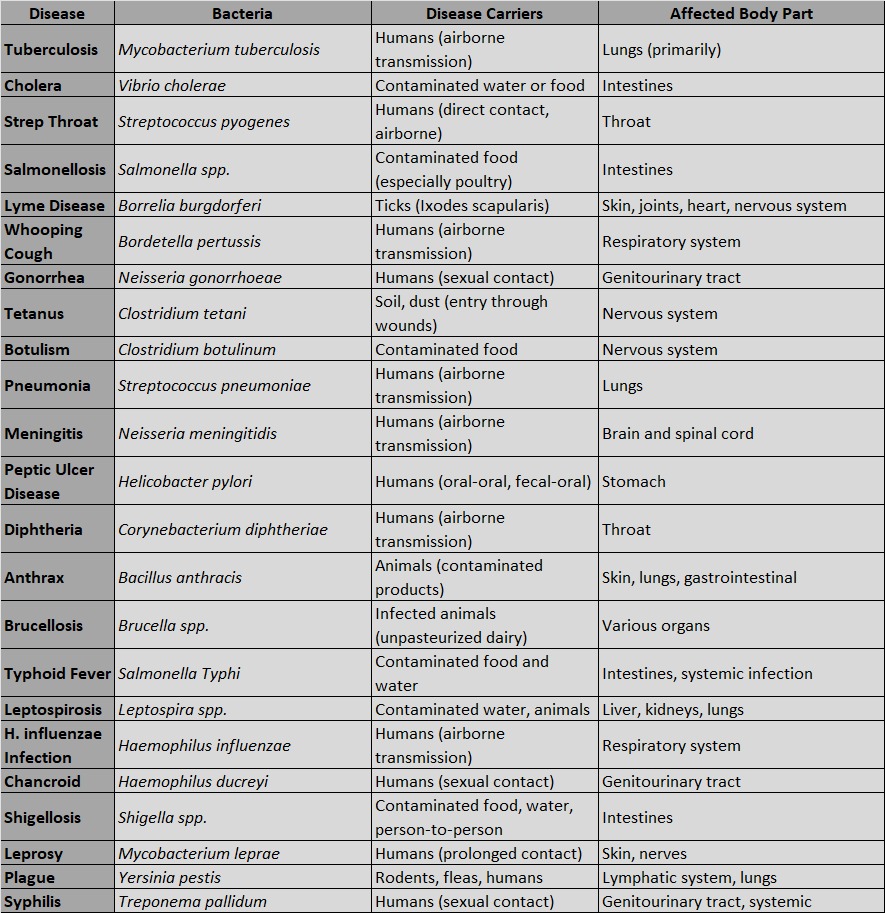Understanding Bacterial Diseases: A Key Topic for Competitive Exams
As students preparing for competitive exams like SSC CGL, CHSL, Railway Recruitment Board (RRB) Exams like NTPC and various state-level entrance tests, it’s essential to have a comprehensive understanding of important topics, including infectious diseases. Bacterial diseases are significant in the realm of public health and can appear in exam questions. Here, we present a detailed overview of notable bacterial diseases that you should know.
Key Bacterial Diseases
1. Tuberculosis (TB)
- Bacteria: Mycobacterium tuberculosis
- Carriers: Humans (airborne transmission)
- Affected Body Parts: Primarily the lungs
- Description: TB remains one of the leading causes of death from infectious diseases globally. Understanding its symptoms, transmission, and treatment options is crucial for any public health discussion.
2. Cholera
- Bacteria: Vibrio cholerae
- Carriers: Contaminated water or food
- Affected Body Parts: Intestines
- Description: Cholera is a severe diarrheal illness that can lead to dehydration and death if untreated. It highlights the importance of clean water and sanitation practices in preventing outbreaks.
3. Strep Throat
- Bacteria: Streptococcus pyogenes
- Carriers: Humans (direct contact, airborne)
- Affected Body Parts: Throat
- Description: Strep throat is a common bacterial infection that can lead to complications like rheumatic fever. Recognizing its symptoms is vital for early diagnosis and treatment.
4. Salmonellosis
- Bacteria: Salmonella spp.
- Carriers: Contaminated food, especially poultry
- Affected Body Parts: Intestines
- Description: This infection is often linked to improper food handling and preparation. Understanding food safety measures is crucial for preventing outbreaks.
5. Lyme Disease
- Bacteria: Borrelia burgdorferi
- Carriers: Ticks
- Affected Body Parts: Skin, joints, heart, nervous system
- Description: Lyme disease is transmitted through tick bites and can cause long-term health issues if not treated promptly. Awareness of tick prevention is essential for those living in endemic areas.
6. Whooping Cough
- Bacteria: Bordetella pertussis
- Carriers: Humans (airborne)
- Affected Body Parts: Respiratory system
- Description: Whooping cough is a highly contagious respiratory disease. Vaccination is key to preventing its spread, and understanding vaccine schedules is important for public health.
7. Gonorrhea
- Bacteria: Neisseria gonorrhoeae
- Carriers: Humans (sexual contact)
- Affected Body Parts: Genitourinary tract
- Description: Gonorrhea is a sexually transmitted infection that can lead to serious reproductive health issues. Knowledge of safe sex practices and testing is important for prevention.
8. Tetanus
- Bacteria: Clostridium tetani
- Carriers: Soil and dust
- Affected Body Parts: Nervous system
- Description: Tetanus causes severe muscle spasms and can be life-threatening. Understanding the importance of vaccinations in preventing tetanus is crucial for personal and public health.
9. Botulism
- Bacteria: Clostridium botulinum
- Carriers: Contaminated food
- Affected Body Parts: Nervous system
- Description: Botulism is a rare but serious illness caused by a toxin that can lead to paralysis. Proper food preservation methods are essential to prevent this disease.
10. Pneumonia
- Bacteria: Streptococcus pneumoniae
- Carriers: Humans (airborne)
- Affected Body Parts: Lungs
- Description: Pneumonia can range from mild to life-threatening. Understanding its causes, symptoms, and the importance of vaccination can help in prevention efforts.
11. Meningitis
- Bacteria: Neisseria meningitidis
- Carriers: Humans (airborne)
- Affected Body Parts: Brain and spinal cord
- Description: Meningitis is an inflammation of the protective membranes covering the brain and spinal cord. It can be deadly, making awareness of symptoms and the importance of vaccination critical.
12. Peptic Ulcer Disease
- Bacteria: Helicobacter pylori
- Carriers: Humans (oral-oral, fecal-oral)
- Affected Body Parts: Stomach
- Description: This condition can cause chronic stomach pain and complications if left untreated. Understanding its link to diet and lifestyle is important for prevention.
13. Diphtheria
- Bacteria: Corynebacterium diphtheriae
- Carriers: Humans (airborne)
- Affected Body Parts: Throat
- Description: Diphtheria is a serious infection that can lead to difficulty breathing. Vaccination remains the best form of prevention.
14. Anthrax
- Bacteria: Bacillus anthracis
- Carriers: Animals (contaminated products)
- Affected Body Parts: Skin, lungs, gastrointestinal tract
- Description: Anthrax can be contracted through contact with infected animals or contaminated products. Understanding its routes of transmission is crucial for prevention.
15. Brucellosis
- Bacteria: Brucella spp.
- Carriers: Infected animals (unpasteurized dairy)
- Affected Body Parts: Various organs
- Description: This disease is often associated with livestock and can cause serious long-term health issues. Awareness of safe food practices is essential for prevention.
16. Typhoid Fever
- Bacteria: Salmonella Typhi
- Carriers: Contaminated food and water
- Affected Body Parts: Intestines, systemic infection
- Description: Typhoid fever is preventable through vaccination and proper sanitation. Understanding its transmission routes is crucial for public health education.
17. Leptospirosis
- Bacteria: Leptospira spp.
- Carriers: Contaminated water, animals
- Affected Body Parts: Liver, kidneys, lungs
- Description: Leptospirosis is linked to exposure to contaminated water and can cause severe illness. Awareness of environmental risks is important for prevention.
18. Syphilis
- Bacteria: Treponema pallidum
- Carriers: Humans (sexual contact)
- Affected Body Parts: Genitourinary tract, systemic
- Description: Syphilis has a long history and continues to be a significant public health concern. Understanding its stages and treatment options is vital for sexual health education.
Understanding these diseases not only aids in competitive exams but also equips you with knowledge about public health issues. Remember to review related topics such as prevention, treatment, and global health impacts, as these can often be intertwined in exam questions. Stay informed, and good luck with your preparations!

[…] Previous Post: Diseases Caused by Bacteria […]